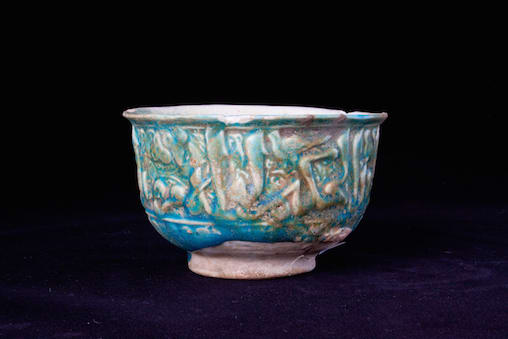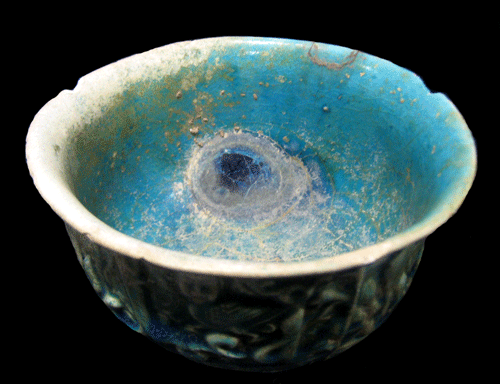Turquoise Glazed Bowl with Inscriptions, 1100 CE - 1300 CE
Glazed Earthenware
5.5 x 3.5
AMD.02
Further images
Bowl of semispherical body on medium-heigh foot ring. Whereas the interior bears no decoration, the entire exterior of this molded monochrome glazed bowl is magnificently inscribed with regal benedictions interspersed...
Bowl of semispherical body on medium-heigh foot ring.
Whereas the interior bears no decoration, the entire exterior of this molded monochrome glazed bowl is magnificently inscribed with regal benedictions interspersed with the images of four birds in low relief perched on the letters of the inscription itself and the figure of a crowned harpy (bird figures with humanoid heads). Several other birds of smaller dimensions are depicted among the letters.
The significance of the Harpy and her relevance in Islamic iconography is vastly associated to the ascension of Prophet Muhammad to heaven, which was made possible with the aid of Al-Buraq, a mythical creature portrayed with a human head, bearing to a high degree the resemblance of a harpy. The features of the Harpy on this bowl correspond to a typology found in both Saljuq painting and sculpture. Like other mythical creatures in Islamic art, the aesthetic evolution and decorative use of harpies has been influenced by different traditions of other cultures. Harpies had a specific meaning in Islam which is yet to be fully determined but they always feature as decorative elements of generally positive connotations.
The importance of birds with humanoid heads in Islamic pottery, which bear wings on either side and a body terminating in tail feathers, is reinforced by certain ceramic comparisons. Lobed bowls and cups with images of harpies similar to this, both molded and painted, are also found decorating the long neck of a certain type of ceramic bottles of the same period.
Whereas the interior bears no decoration, the entire exterior of this molded monochrome glazed bowl is magnificently inscribed with regal benedictions interspersed with the images of four birds in low relief perched on the letters of the inscription itself and the figure of a crowned harpy (bird figures with humanoid heads). Several other birds of smaller dimensions are depicted among the letters.
The significance of the Harpy and her relevance in Islamic iconography is vastly associated to the ascension of Prophet Muhammad to heaven, which was made possible with the aid of Al-Buraq, a mythical creature portrayed with a human head, bearing to a high degree the resemblance of a harpy. The features of the Harpy on this bowl correspond to a typology found in both Saljuq painting and sculpture. Like other mythical creatures in Islamic art, the aesthetic evolution and decorative use of harpies has been influenced by different traditions of other cultures. Harpies had a specific meaning in Islam which is yet to be fully determined but they always feature as decorative elements of generally positive connotations.
The importance of birds with humanoid heads in Islamic pottery, which bear wings on either side and a body terminating in tail feathers, is reinforced by certain ceramic comparisons. Lobed bowls and cups with images of harpies similar to this, both molded and painted, are also found decorating the long neck of a certain type of ceramic bottles of the same period.













